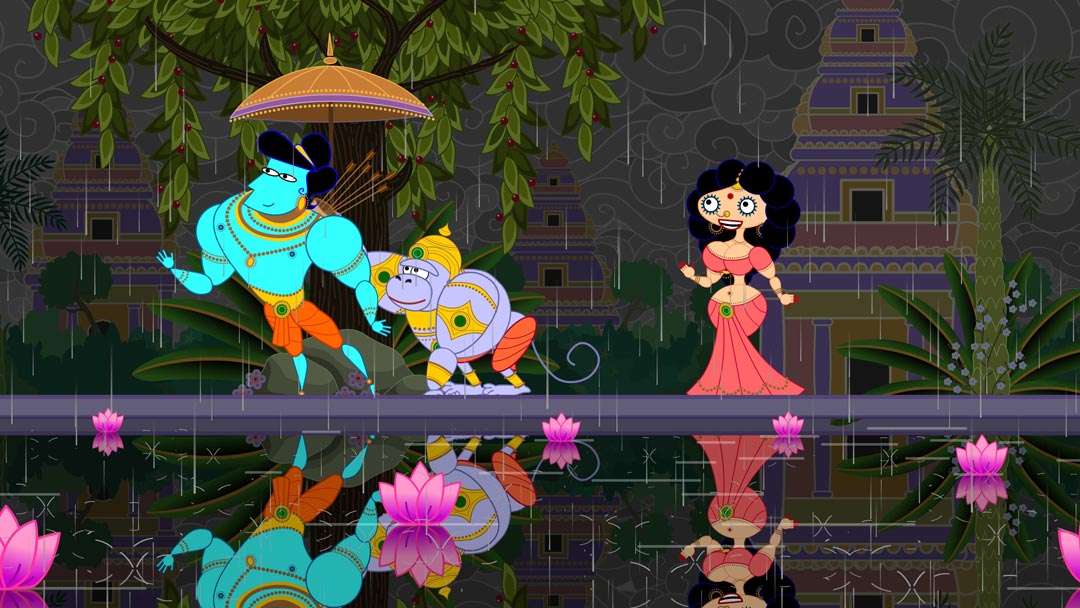Sita Sings the Blues (2008): Filmmaker and animator Nina Paley faced a lot of backlash for her film Sita Sings the Blues (2008). However, the reasons given by those who criticized her work—particularly, members of a great many right-wing, religious Hindu groups across the globe—were far from being valid as they were primarily based on them considering her interpretation of the ancient Indian epic, Ramayana, to be inaccurate.
But, as AK Ramanujan specifies in his essay, ‘Three Hundred R.amayanas: Five Examples and Three Thoughts on Translation’ (1987), there are multitudinous adaptations of Ramayana that have existed in and outside South Asia for centuries. Yet, certain Hindu communities solely consider five versions of the epic—the most popular of them being the one written by the ancient poet Valmiki—as the actual Ramayana. Keeping that in mind, Paley’s reading of the epic can, in its truest sense, be viewed as one out of the numerous variations that continue to exist even today.
Nevertheless, even if her creative work does not deserve to be censored and condemned, it must be understood that there are several moments in the film that make it quite obvious how Paley was still operating – while creating Sita Sings the Blues – under what Toni Morrison once referred to as the ‘white gaze.’ Janice Gassam Asare sheds light on Morrison’s theory about the white gaze in their publication for Forbes by reiterating how “…the white gaze can be conceptualized as the assumed white reader…The white gaze can be expanded to mean the ways in which whiteness dominates how we think and operate within society.” If the dialogues and scenes of Paley’s film are thoroughly examined, it becomes clear that she constantly walks over India, its women, and its culture while scrutinizing them.
Sharmila Lodhia, in her analysis of the film, writes how Paley uses “…everyday and sometimes coarse dialogue to tell the story, for example, the references to Sita’s breasts as “big, round, firm, juicy lotuses.” These descriptions of Sita’s physique in the film not only come across as being extremely Western but also as misogynistic. In addition to this, there are sequences where the character of Sita is shown to be flying across the screen as her husband, Rama, strikes her with his foot.
By sexualizing Sita and further portraying her as a powerless woman getting blootered by her husband, Paley, instead of doing away with the problematic characterizations of a few characters in Ramayana, ends up propagating the very character tropes that eventually lead to Sita’s objectification in the story.
The aforementioned physical attributes assigned to Sita’s animated caricature in the film are also discussed by Ipshita Chanda in her research when she writes: “…the representation of Sita is the cartoon, drawn in even more exaggerated outlines with overstated secondary sexual characteristics. The voluptuous cartoon of Sita’s counterpart is a bare blue-bodied Rama drawn to resemble the muscled Johnny Bravo, a cartoon character who is all man and putty in the hands of women.”
These cartoons ultimately lead the characters of Sita and Rama to be viewed through the lens of gender binaries, which Paley aims to criticize. As Chanda elucidates, “The visual text is a representation of a couple with exaggerated physical outlines which, in turn, define and identify masculinity and femininity, Rama and Sita.”
Since Sita Sings the Blues is actually a work of fiction, the extreme masculinization and feminization of the two characters, rather than adding elements of hilarity in the recital, reinforce certain patriarchal stereotypes about how women and men ought to look, as can be deciphered from the similarities that Rama’s cartoon shares with Johnny Bravo — an American cartoon character.

Alongside the previously mentioned points, an important aspect of the white gaze can be observed once the segment shifts to a parallel narrative in which Paley’s own character finally reaches India to accompany her husband. The moment they meet, her husband exclaims, “We’re in India; no kissing in public!” This reveals his preconceived notions about the country, which he goes on to make his wife develop, as well. Paley, in that particular scene, has just arrived in India. Thus, this interaction, in a way, affects her thoughts about it.
These thoughts are also brought out later on in the story when the different narrators discuss the plot of Ramayana. As they talk about Rama’s victory over Ravana in the war the former waged in order to rescue his wife, one of them says, “When he saw her in Lanka, he kissed her…” and another narrator dismisses that by saying, “No, he was very cold to her.” Once again, this establishes that Paley’s interpretation of the epic is significantly shaped by her prejudices.
Lodhia writes about Paley’s misconceptions about India in her paper by stating how she had once claimed that Indian women were treated as “…second-class citizens, unable to walk alone at night and not expected to have an identity separate from their husbands.” Lodhia further mentions how “… reductionist assumptions about the status of Indian women taint Paley’s statement….” Perhaps, this is the very assumption that reflects how she shapes the characters and the narration style in her film.
Additionally, a common debate that Sita Sings the Blues has often stirred is whether or not cultural appropriation exists in it. Many have argued that Paley has used the story of Ramayana for her personal gain. But others have also explained that she has not profited from her film’s circulation because it is made free to the masses. Nonetheless, it is still important to understand the possibility of cultural appropriation despite Paley not making any financial profits through Sita Sings the Blues. As Lodhia accentuates in her essay:
“The problem with cultural appropriation…is also that pattern of disturbing consumption that bell hooks conceptualizes as “eating the Other”…Hindu imagery, when consumed in a piecemeal way, satiates a desire to experience the Other while simultaneously enabling the purchaser to amass currency as a cosmopolitan consumer.”
Paley’s film does not, in any way, involve her appreciating Indian culture, even if she tries her best to draw a parallel between her own life events and the plot of Ramayana. She might have corroborated how immersing herself in the epic helped her come out of the grief she’d experienced after her divorce.
Yet, the characters and the overall storyline of the epic are solely ridiculed in her film without there being any attempt from her side to point out how and why she found its plot relatable. As mentioned in an article on the University of Wisconsin-Madison’s page, “Cultural Appreciation is about honoring a culture whereas Cultural Appropriation is dishonoring or demeaning a culture.”
Sita Sings the Blues, in a way, achieved something that popular media content such as Indian filmmaker Ramanand Sagar’s Ramayan (1987) and even author Amish Tripathi’s Ram Chandra book series (2015-Present) couldn’t—it tried to highlight the plight of Sita’s character without centering the entire narrative around the male characters.
However, even then, it somehow failed to do justice to the various versions of Ramayana that exist around the world by reducing the film to a very Westernized analysis of the epic. While it is fair for individuals living in the Global South to voice their disapproval about their own countries, it is unacceptable for Westerners to promulgate beliefs that non-western countries, such as India, have cultures inferior to their own.
Related to Sita Sings the Blues (2008): Is American Auto the Heir to the Office as the Great American Work Place Comedy?
Sita Sings the Blues (2008) Links: IMDb, Wikipedia
Sita Sings the Blues (2008) Cast: Annette Hanshaw, Aseem Chhabra, Bhavana Nagulapally
Bibliography:
- Lodhia, Sharmila. “Deconstructing Sita’s Blues: Questions of Mis/Representation, Cultural Property, and Feminist Critique in Nina Paley’s Ramayana.” Feminist Studies, Inc., vol. 41, no. 2, Jan. 2015, pp. 371–408. Ramanujan, A. K. The Collected Essays of A. K. Ramanujan. Oxford UP, 2004.
- Asare, Janice Gassam. “Understanding the White Gaze and How It Impacts Your Workplace.” Forbes, 29 Dec. 2021
- Chanda, Ipshita. “An Intermedial Reading of Paley’s Sita Sings the Blues.” CLCWeb, vol. 13, no. 3, Purdue UP, Sept. 2011.
- “Inclusive Language: Cultural Appreciation and Cultural Appropriation.” University Housing, 21 Oct. 2022.






![Good Manners [2018]: ‘BUFF’ Capsule Review](https://79468c92.delivery.rocketcdn.me/wp-content/uploads/2018/03/goodmanners3-768x384.png)